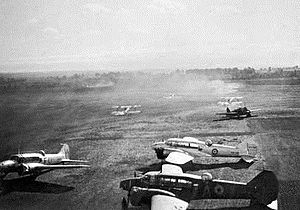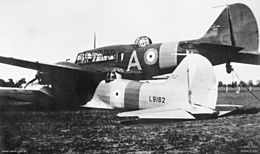- No. 2 Service Flying Training School RAAF
-
No. 2 Service Flying Training School RAAF 
No. 2 SFTS, c. September 1940: three Ansons (foreground) with a Wirraway (middle right) and three Tiger Moths (rear)Active 1940–1942 Allegiance  Australia
AustraliaBranch  Royal Australian Air Force
Royal Australian Air ForceRole Advanced flying training Garrison/HQ RAAF Station Forest Hill Nickname "Scherger's Concentration Camp" Commanders Notable
commandersFrederick Scherger (1940–41)
Charles Eaton (1941–42)No. 2 Service Flying Training School (No. 2 SFTS) was a flying training school of the Royal Australian Air Force (RAAF) during World War II. It was formed in July 1940, under the command of Group Captain Frederick Scherger. Responsible for intermediate and advanced instruction of pilots under the Empire Air Training Scheme (EATS), the school was based at RAAF Station Forest Hill near Wagga Wagga, New South Wales, and primarily operated CAC Wirraway and Avro Anson aircraft. In 1942 the RAAF rationalised its EATS facilities, dividing the personnel and equipment of No. 2 SFTS between Nos. 5 and 7 Service Flying Training Schools at Uranquinty and Deniliquin, respectively. No. 2 SFTS was disbanded that April.
Contents
History
RAAF aircrew training expanded dramatically following the outbreak of World War II, in response to Australia's participation in the Empire Air Training Scheme (EATS). The Air Force's pre-war flight training facility, No. 1 Flying Training School at RAAF Station Point Cook, Victoria, was supplanted in 1940–41 by twelve Elementary Flying Training Schools (EFTS), eight Service Flying Training Schools (SFTS), and Central Flying School (CFS).[1][2] While CFS turned out new flight instructors, the EFTS provided basic training to prospective pilots who, if successful, would go on to SFTS for further instruction that focussed on operational (or "service") flying.[1][3] The course at SFTS typically consisted of two streams, intermediate and advanced, and included such techniques as instrument flying, night flying, advanced aerobatics, formation flying, dive bombing, and aerial gunnery.[1][4] The total duration varied during the war as demand for aircrew rose and fell. Initially running for 16 weeks, the course was cut to 10 weeks (which included 75 hours flying time) in October 1940. A year later it was raised to 12 weeks (including 100 hours flying time), and again to 16 weeks two months later. It continued to increase after this, peaking at 28 weeks in June 1944.[4]
No. 2 Service Flying Training School (No. 2 SFTS) was formed at RAAF Station Forest Hill, near Wagga Wagga, New South Wales, on 1 July 1940.[5] Its inaugural commander was Group Captain Frederick Scherger, whose strict discipline and German ancestry quickly earned his establishment the nickname "Scherger's Concentration Camp".[6] One of the school's instructors was Flying Officer Bill Newton, later to be awarded the Victoria Cross for bombing raids in New Guinea.[7] Forest Hill was a new air base, and roads and buildings were still under construction when its first course of flying training commenced with Avro Ansons on 29 July.[5][8] One of the Ansons crashed in August, killing its instructor and a student. Later that month the second flying course began, on CAC Wirraways. The school was then reorganised into Initial and Advanced Squadrons.[5] On 29 September, two Ansons collided in mid-air and became locked together. Both navigators bailed out, to be followed shortly afterwards by the injured pilot of the lower aircraft. The pilot of the upper Anson, however, found that he was able to control the interlocked aircraft using his ailerons and flaps, coupled with the engine power of the Anson underneath. He then managed to make a successful emergency landing in a paddock near the town of Brocklesby.[5][9]
No. 2 SFTS underwent further reorganisation in February 1941 with the establishment of Intermediate Squadron; successful students from this unit were awarded their wings before proceeding to Advanced Squadron. Another new unit, Maintenance Squadron, formed in March. From this point on, the Ansons were phased out at the school, as single-engined and multi-engined aircraft training was split up on orders of the RAAF Air Board. By the end of July, only Wirraways were in operation, their numbers eventually reaching 96.[5] In September, Group Captain Scherger departed Forest Hill to take over RAAF Station Darwin, Northern Territory, from Group Captain Charles "Moth" Eaton, who in turn assumed command of No. 2 SFTS the next month.[10][11] Following the outbreak of the Pacific War in December 1941, the school's Wirraways were classified as Second Line (Reserve) aircraft in the defence of Australia, while the base was fortified with sandbags, trenches, and gun pits.[5][12] On 1 January 1942, No. 60 Squadron was established at Wagga Wagga from No. 2 SFTS aircraft and personnel.[13] This unit formed part of the expansion of the Australian military in response to the rapid Japanese advance in the first month of the war.[14] A contingent of 68 WAAAFs also began arriving at Forest Hill in January.[5]
The Air Board subsequently rationalised EATS facilities in southern New South Wales, dividing the staff and aircraft of No. 2 SFTS between Nos. 5 and 7 Service Flying Training Schools at the nearby RAAF Stations Uranquinty and Deniliquin, respectively.[5] Group Captain Eaton remained in command of the school until shortly before its disbandment on 3 April 1942. No. 2 SFTS had suffered a total of four serious accidents in Ansons and eleven in Wirraways, resulting in the deaths of three instructors and four students. Out of some 600 entrants, just over 550 pilots graduated from the school,[5] among them Clive Caldwell, later to become Australia's leading fighter ace of the war, and future Prime Minister John Gorton.[6][15] No. 60 Squadron was also disbanded on 3 April, after a brief career during which its activities had been limited to training exercises.[13]
Notes
- ^ a b c Stephens, The Royal Australian Air Force, pp. 67–70
- ^ Gillison, Royal Australian Air Force 1939–1942, p. 111
- ^ Gillison, Royal Australian Air Force 1939–1942, p. 97
- ^ a b Gillison, Royal Australian Air Force 1939–1942, p. 109
- ^ a b c d e f g h i RAAF Historical Section, Units of the Royal Australian Air Force, Vol. 8, pp. 102–103
- ^ a b Alexander, Clive Caldwell, pp. 12–13
- ^ Weate, Bill Newton VC, pp. 19–22
- ^ Gillison, Royal Australian Air Force 1939–1942, p. 56
- ^ Gillison, Royal Australian Air Force 1939–1942, pp. 82–83
- ^ Stephens, The Royal Australian Air Force, p. 136
- ^ Eaton, Charles at Australian Dictionary of Biography. Retrieved on 20 February 2011.
- ^ Gillison, Royal Australian Air Force 1939–1942, pp. 234–238
- ^ a b RAAF Historical Section, Units of the Royal Australian Air Force, Vol. 2, p. 39
- ^ Eather, Flying Squadrons of the Australian Defence Force, p. 81
- ^ Odgers, Mr Double Seven, pp. 13–15
References
- Alexander, Kristen (2006). Clive Caldwell: Air Ace. Crows Nest, New South Wales: Allen & Unwin. ISBN 1741147050.
- Eather, Steve (1995). Flying Squadrons of the Australian Defence Force. Weston Creek, Australian Capital Territory: Aerospace Publications. ISBN 1875671153.
- Gillison, Douglas (1962). Australia in the War of 1939–1945: Series Three (Air) Volume I – Royal Australian Air Force 1939–1942. Canberra: Australian War Memorial. OCLC 2000369. http://www.awm.gov.au/histories/second_world_war/volume.asp?levelID=67912.
- Odgers, George (2008). Mr Double Seven. Canberra: Air Power Development Centre. ISBN 9781920800307. http://airpower.airforce.gov.au/Publications/Details/228/Mr-Double-Seven.aspx.
- RAAF Historical Section (1995). Units of the Royal Australian Air Force: A Concise History. Volume 2: Fighter Units. Canberra: Australian Government Publishing Service. ISBN 0644427949.
- RAAF Historical Section (1995). Units of the Royal Australian Air Force: A Concise History. Volume 8: Training Units. Canberra: Australian Government Publishing Service. ISBN 0644428007.
- Stephens, Alan (2006) [2001]. The Royal Australian Air Force: A History. London: Oxford University Press. ISBN 0195555414.
- Weate, Mark (1999). Bill Newton VC: The Short Life of a RAAF Hero. Loftus, New South Wales: Australian Military History Publications. ISBN 1876439785.
Further reading
- Ilbery, Peter (2002). Hatching an Air Force: 2 SFTS, 5 SFTS, 1 BFTS Uranquinty and Wagga-Wagga. Maryborough, Queensland: Banner books. ISBN 1875593241.
Categories:- RAAF training units
- Military units and formations established in 1940
- Military units and formations disestablished in 1942
Wikimedia Foundation. 2010.


